安川plcmpe720使用方法基础
- 格式:pdf
- 大小:7.43 MB
- 文档页数:50
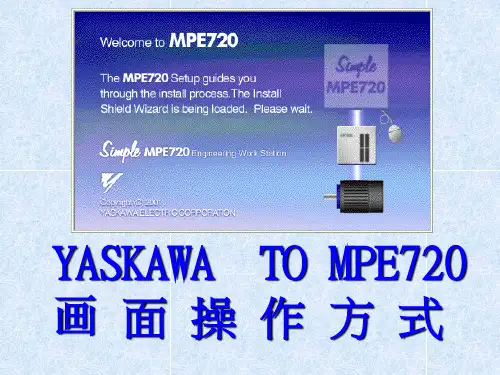
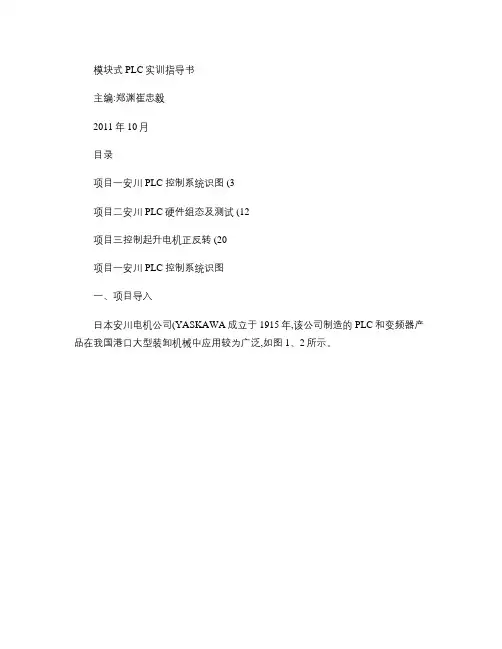
模块式PLC实训指导书主编:郑渊崔忠毅2011年10月目录项目一安川PLC控制系统识图 (3项目二安川PLC硬件组态及测试 (12项目三控制起升电机正反转 (20项目一安川PLC控制系统识图一、项目导入日本安川电机公司(YASKAWA成立于1915年,该公司制造的PLC和变频器产品在我国港口大型装卸机械中应用较为广泛,如图1、2所示。
图1 安川模块式PLC 图2 安川G7变频器图3所示为轮胎吊实训台,该实训台采用安川PLC和变频器,其控制系统与港口实际PLC控制系统基本一致,本项目的任务是读懂该实训台PLC控制系统电气图纸,从而对模块式PLC控制系统有一个整体上的把握。
图3 轮胎吊实训台二、项目分析模块式PLC控制系统由于一般应用于较为复杂的电气控制中,所以其电气图纸相对于整体式PLC控制系统或继电器控制系统要复杂一些,但是也可以分为主电路和控制电路两部分。
对于采用模块式PLC控制系统的港口大型装卸机械来讲,可以分成以下几个部分:(一主电路安川PLC安川变频器1、主驱动电路,例如驱动大机各机构动作的电路,现在一般采用变频调速。
2、辅助机构驱动电路,例如大机各机构风机电路、制动器电路等,一般采用工频电源,不需变频调速。
(二控制电路1、PLC外部控制电路,该部分电路既不是PLC输入回路,也不是PLC输出回路,而主要是输入输出的中继电路或者安全电路。
2、PLC模块配置电路,该部分电路表明PLC控制系统采用何种CPU模块、电源模块、输入输出模块、特殊功能模块、通讯模块等,同时说明了PLC控制系统的网络通讯结构和输入输出模块的地址分配等重要信息。
3、PLC输入回路,一般每页图纸绘制16个输入点,并标明每个输入点所对应输入设备的功能。
4、PLC输出回路,一般每页图纸绘制16个输出点,并标明每个输出点所对应输出设备的功能。
二、项目实施(一供电线路1、主电路供电如附录P1所示,轮胎吊实训台采用主变压器输出的380V工频交流电源供电,经空气开关QF1给主电路供电。

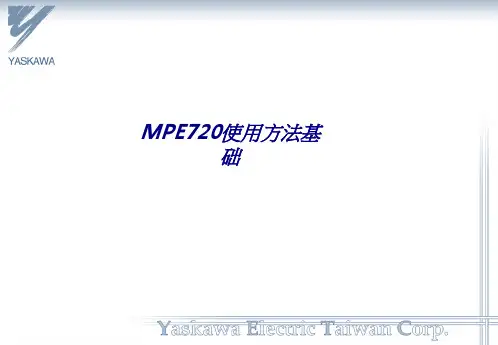
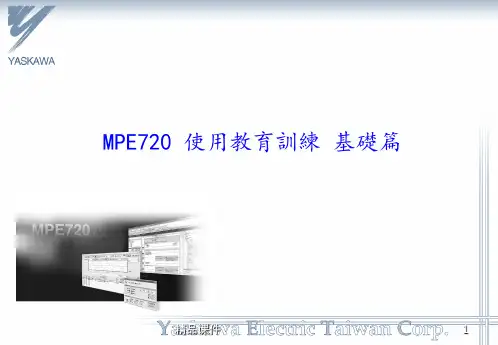
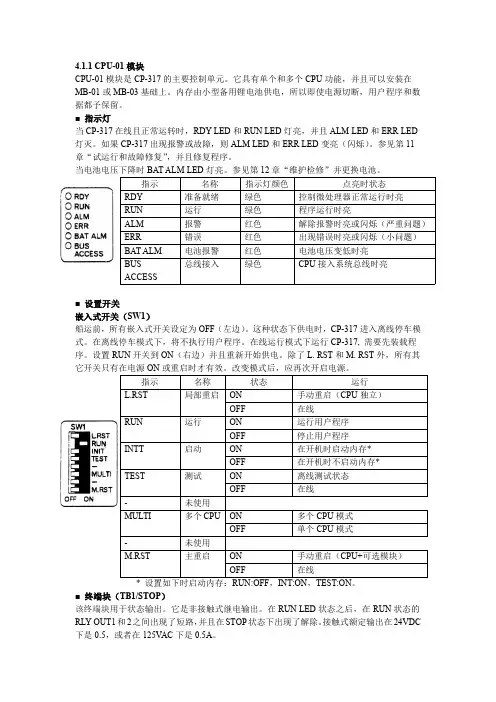

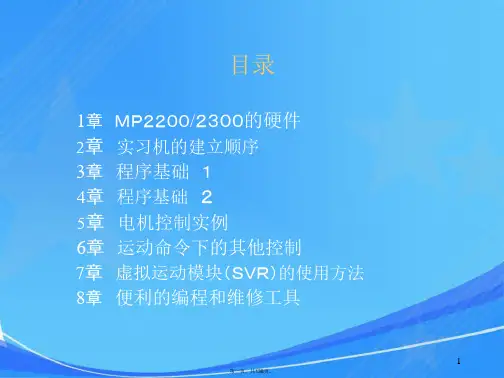
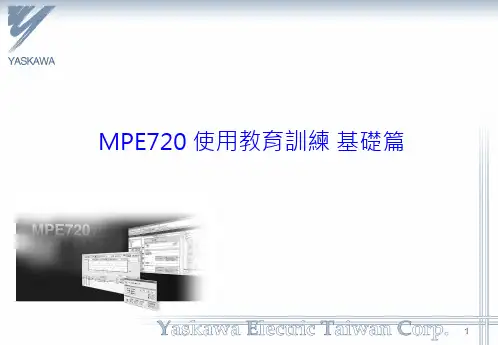
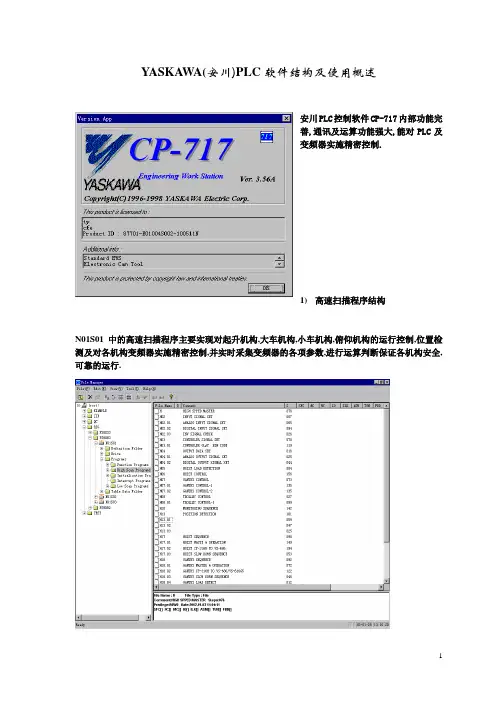
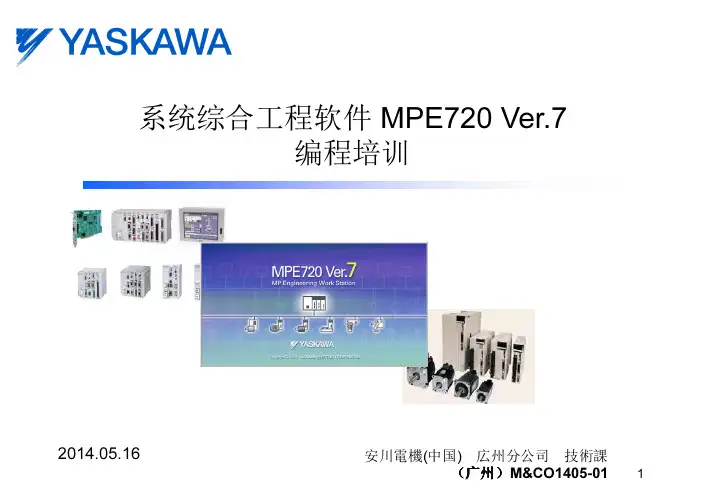
2开始DriveWizard加上按照下面的方向开始使用DriveWizard: 2.1启动程序有三种方法可以启动一个会话DriveWizard加上:从开始菜单从快捷・・・通过双击一个项目文件。
2.1.1从开始菜单遵循这些指令从开始菜单中打开DriveWizard加上:1)打开开始菜单在Windows任务栏。
2)去编程菜单,打开编程文件夹。
3)打开文件夹标记为“YE_Applications”。
4)选择“DriveWizard加上2.1.2从捷径双击快捷方式“DriveWizard +”标志2.1.3双击项目文件DriveWizard加上可以通过双击打开一个项目文件。
1)打开Windows资源管理器2)双击项目文件的图标。
注意:项目文件保存到桌面也可以用来打开一个会话DriveWizard加上通过双击图标。
2.2连接驱动和PC通过Com端口DriveWizard加上首次打开时,启动窗口所示将出现在电脑显示器上。
第一个窗口出现问如果用户想连接到驱动器或打开一个项目文件。
连接:电脑连接到驱动编辑参数和执行测试运行。
打开项目文件:驱动器并不一定需要连接到编辑一个项目文件。
连接一个驱动器,DriveWizard加上要求某些数据输入“连接设置”和“协议设置”1)指定连接设置端口选择驱动的com端口连接。
DriveWizard加上将列出可用的com端口正在使用的电脑。
这电脑显示会有所不同。
媒体选择的媒体设置com地址:搜索或单身。
如果你知道com地址,进入这里。
如果不是,选择“搜索”和DriveWizard加上会自动搜索地址。
地址设置com地址驱动参数设置。
这个设置将显示为灰色,当“搜索”已经选定的媒体。
2)选择协议设置集驱动的通信速度和电脑。
这些设置不同的驱动模型,参考说明书是否正确设置。
个基点选择1200个基点,2400个基点,4800个基点,9600个基点,19200个基点,38400个基点,57600个基点,76800个基点,115200个基点平价选择None,奇怪,甚至数据长度7位/ 8位停止位1位/ 2位3)选择“连接”DriveWizard加上将尝试连接到驱动器。
YASKAWA Electric CorporationMP Series SIO(Extension) Driver1System Configuration (3)2Selection of External Device (6)3Example of Communication Setting (7)4Setup Items (9)5Cable Diagram (14)6Supported Device (16)7Device Code and Address Code (17)8Error Messages (18)IntroductionThis manual describes how to connect the Display and the External Device (target PLC).In this manual, the connection procedure will be described by following the below sections:1System ConfigurationThis section shows the types of ExternalDevices which can be connected and SIOtype.)"1 System Configuration" (page 3)2Selection of External DeviceSelect a model (series) of the ExternalDevice to be connected and connectionmethod.)"2 Selection of External Device" (page 6)3Example of Communication Settings This section shows setting examples forcommunicating between the Display andthe External Device.)"3 Example of Communication Setting"(page 7)4Setup ItemsThis section describes communicationsetup items on the Display.Set communication settings of the Displaywith GP-Pro Ex or in offline mode.)"4 Setup Items" (page 9)5Cable DiagramThis section shows cables and adaptersfor connecting the Display and theExternal Device.)"5 Cable Diagram" (page 14) Operation1System ConfigurationThe system configuration in the case when the External Device of YASKAWA Electric Corporation and the Display are connected is shown. Connection Configuration•1:1 ConnectionSeriesCPULink I/F SIO TypeSetting Example Cable Diagram MP2000MP2300MP2200MP2310MP2300SSerial port on 218IF-01RS232C "3.1 Setting Example 1" (page 7)" Cable Diagram 1" (page 14)Serial port on 218IF-02RS232C "3.1 Setting Example 1" (page 7)" Cable Diagram 1" (page 14)Serial port on 260IF-01RS232C "3.1 Setting Example 1" (page 7)" Cable Diagram 1" (page 14)Serial port on 261IF-01RS232C "3.1 Setting Example 1" (page 7)" Cable Diagram 1" (page 14)PORT on 217IF-01RS232C"3.1 Setting Example 1" (page 7)" Cable Diagram 1" (page 14)IPC COM PortWhen connecting IPC with an External Device, the COM port used depends on the series and SIO type. Please refer to the IPC manual for able portDIP Switch setting: RS-232CSeriesUsable PortRS-232CRS-422/485(4 wire)RS-422/485(2 wire)PS-2000BCOM1*1, COM2, COM3*1, COM4*1The RI/5V can be switched. Use the IPC’s switch to change if necessary.--PS-3450A, PS-3451A,PS3000-BA, PS3001-BD COM1, COM2*1*2COM2*1*2COM2*1*2PS-3650A (T41 model),PS-3651A (T41 model)COM1*1--PS-3650A (T42 model),PS-3651A (T42 model)COM1*1*2, COM2COM1*1*2COM1*1*2PS-3700A (Pentium®4-M)PS-3710A COM1*1, COM2*1, COM3*2, COM4*2Set up the SIO type with the DIP Switch. Please set up as follows according to SIO type to be 3*2COM3*2PS-3711A COM1*1, COM2*2COM2*2COM2*2PS4000*3*3When making communication between an External Device and COM port on the Expansion slot, only RS-232C is supported. However, ER (DTR/CTS) control cannot be executed because of the specification of COM port.For connection with External Device, use user-created cables and disable Pin Nos. 1, 4, 6 and 9. Please refer to the IPC manual for details of pin layout.COM1, COM2--PL3000COM1*1*2, COM2*1, COM3, COM4COM1*1*2COM1*1*2DIP SwitchSetting Description1OFF *1*1When using PS-3450A, PS-3451A, PS3000-BA and PS3001-BD, turn ON the set value.Reserved (always OFF)2OFF SIO type: RS-232C3OFF 4OFF Output mode of SD (TXD) data: Always output5OFF Terminal resistance (220Ω) insertion to SD (TXD): None 6OFF Terminal resistance (220Ω) insertion to RD (RXD): None 7OFF Short-circuit of SDA (TXA) and RDA (RXA): Not available 8OFF Short-circuit of SDB (TXB) and RDB (RXB): Not available 9OFF RS (RTS) Auto control mode: Disabled10OFFDIP Switch setting: RS-422/485 (4 wire)DIP Switch setting: RS-422/485 (2 wire)DIP SwitchSetting Description1OFF Reserved (always OFF)2ON SIO type: RS-422/4853ON 4OFF Output mode of SD (TXD) data: Always output5OFF Terminal resistance (220Ω) insertion to SD (TXD): None 6OFF Terminal resistance (220Ω) insertion to RD (RXD): None 7OFF Short-circuit of SDA (TXA) and RDA (RXA): Not available 8OFF Short-circuit of SDB (TXB) and RDB (RXB): Not available 9OFF RS (RTS) Auto control mode: Disabled10OFFDIP SwitchSetting Description1OFF Reserved (always OFF)2ON SIO type: RS-422/4853ON 4OFF Output mode of SD (TXD) data: Always output5OFF Terminal resistance (220Ω) insertion to SD (TXD): None 6OFF Terminal resistance (220Ω) insertion to RD (RXD): None 7ON Short-circuit of SDA (TXA) and RDA (RXA): Available 8ON Short-circuit of SDB (TXB) and RDB (RXB): Available 9ON RS (RTS) Auto control mode: Enabled10ON2Selection of External DeviceSelect the External Device to be connected to the Display.Setup Items Setup DescriptionNumber of Devices/PLCs Enter an integer from 1 to 4 to define the number of Devices/PLCs to connect to the display.ManufacturerSelect the manufacturer of the External Device to connect. Select "YASKAWA Electric Corporation".SeriesSelect the External Device model (series) and the connection method. Select "MP Series SIO (Extension)".In System configuration, make sure the External Device you are connecting is supported by "MP Series SIO (Extension)".)"1 System Configuration" (page 3)Port Select the Display port to connect to the External Device.Use System AreaCheck this option to synchronize the system data area of the Display and the device (memory) of the External Device. When synchronized, you can use the External Device’s ladder program to switch the display or display the window on the Display.Cf.GP-Pro EX Reference Manual "LS Area (Direct Access Method Area)"This feature can also be set in GP-Pro EX or in the Display's offline mode.Cf.GP-Pro EX Reference Manual "System Settings [Display Unit] - [System Area]Settings Guide"Cf.Maintenance/Troubleshooting Guide "Main Unit - System Area Settings"3Example of Communication SettingExamples of communication settings of the Display and the External Device, recommended by Pro-face, are shown.3.1Setting Example 1Settings of GP-Pro EXCommunication SettingsTo display the setup screen, from the [Project] menu, point to [System Settings] and select [Device/PLC].Device SettingTo display the [Individual Device Settings] dialog box, from [Device-Specific Settings] in the [Device/PLC]window, select the external device and click [Settings].Settings of External DeviceCommunication setting of communication module by ladder software (MPE720).Please refer to the manual of external device for more detail.Ladder Software Setting1Start ladder software, make an order folder and a PLC folder in a root folder.2Click the right button of the PLC which select logon in the displayed menu.3Double-click the [Definition folder]-[Module constitution] of the PLC folder, and display [Engineering Manager].4Select the rack classification and communication module, the pull-down menu in [Controller] of [Engineerring Manager].Set the number corresponding to the slot number that a communication module uses.Select the communication module, setting contents are displayed to [Module details] of [Enginnering Manager].5Double-click the number part at No. in [Module details].Double-click the slot number connecting the ethernet unit.Setup Items Setup DescriptionTransmission Protocol MEMOBUSMaster/Slave SlaveDevice Address Device address of the External DeviceSerial I/F RS-232CTransmission Mode RTUData Length8BitParity Bit evenStop Bit1StopBaud Rate19.2KSending DisableAutomatically Reception Disable6Double-click the "No.1", and set serial communication.Use serial communication setting to forward communication setting and the ladder program to the PLC.7Save setting content and finish [Engineering Manager].8DIP switch "INIT" of a communication module is ON and spend a power supply.9Forward communication setting to a communication module.10Logon the PLC at online and write in the data which transferred at flash memory.11Power supply of PLC is OFF and DIP switch of the INIT is OFF, after spend the power supply of PLC.4Setup ItemsSet communication settings of the Display with GP-Pro EX or in offline mode of the Display.The setting of each parameter must be identical to that of External Device.)"3 Example of Communication Setting" (page 7)4.1Setup Items in GP-Pro EXCommunication SettingsTo display the setup screen, from the [Project] menu, point to [System Settings] and select [Device/PLC].Setup Items Setup DescriptionSIO Type Display the SIO type to communicate with the External Device.Speed Select speed between External Device and Display.Data Length Select data length.Parity Select how to check parity.Stop Bit Select stop bit length.Flow Control Select the communication control method to prevent overflow of transmission and reception data.Timeout Use an integer from 1 to 127 to enter the time (s) for which Display waits for the response from External Device.Retry In case of no response from the External Device, use an integer from 0 to 255 to enter how many times the Display retransmits the command.continued to next pageDevice SettingTo display the [Individual Device Settings] dialog box, from [Device-Specific Settings] in the [Device/PLC]window, select the external device and click [Settings].Wait To SendUse an integer from 0 to 255 to enter standby time (ms) for the Display from receiving packets to transmitting next commands.RI/VCCYou can switch RI/VCC of the 9th pin when you select RS232C for SIO type.It is necessary to change RI/5V by changeover switch of IPC when connect with IPC. Please refer to the manual of the IPC for more detail.Device)"Setup Items Setup DescriptionStation No.Enter a station number of the External Device, using 1 to 63.Setup Items Setup Description4.2Setup Items in Offline ModeCommunication SettingsTo display the setting screen, touch [Device/PLC Settings] from [Peripheral Settings] in offline mode. Touch the External Device you want to set from the displayed list.Cf.Maintenance/Troubleshooting Guide "Offline Mode"•The number of the setup items to be displayed for 1 page in the offline mode depends on the Display in use. Please refer to the Reference manual for details.Device SettingTo display the setting screen, touch [Device/PLC Settings] from [Peripheral Settings]. Touch the External Device you want to set from the displayed list, and touch [Device].RetryIn case of no response from the External Device, use an integer from 0 to 255 to enter how many times the Display retransmits the command.Wait To Send (ms)Use an integer from 0 to 255 to enter standby time (ms) for the Display from receiving packets to transmitting next commands.Setup Items Setup DescriptionDevice/PLC Name Select the External Device for device setting. Device name is a title of External Device set with GP-Pro EX.(Initial value [PLC1])Station No.Enter a station number of the External Device, using 1 to 63.Setup Items Setup DescriptionOptionTo display the setting screen, touch [Device/PLC Settings] from [Peripheral Settings]. Touch the External Device you want to set from the displayed list, and touch [Option].Setup Items Setup DescriptionRI/VCCYou can switch RI/VCC of the 9th pin when you select RS232C for SIO type.It is necessary to change RI/5V by changeover switch of IPC when connect with IPC. Please refer to the manual of the IPC for more detail.5Cable DiagramThe cable diagram shown below may be different from the cable diagram recommended by YASKAWA Electric Corporation. Please be assured there is no operational problem in applying the cable diagram shown in this manual.•The FG pin of the External Device body must be D-class grounded. Please refer to the manual of the External Device for more details.•SG and FG are connected inside the Display. When connecting SG to the External Device, design the system not to form short-circuit loop.•Connect the isolation unit, when communication is not stabilized under the influence of a noise etc..Cable Diagram 1Display(Connection Port)Cable RemarksGP3000 (COM1)GP4000*1 (COM1)ST (COM1)LT3000 (COM1)IPC *2PC/AT*1All GP4000 models except GP-4100 Series and GP-4203T*2Only the COM port which can communicate by RS-232C can be used.)IPC COM Port (page 4)1A User-created cable The cable length must be 15m or less.GP-4105 (COM1)1B User-created cableThe cable length must be 15m or less.LT-4*01TM (COM1)1CRJ45 RS-232C Cable (5m) by Pro-facePFXZLMCBRJR211A)1B)1C)Legend Name Notes(1)RJ45 RS-232C Cable (5m) by Pro-face PFXZLMCBRJR216Supported DeviceRange of supported device address is shown in the table below. Please note that the actually supported range of the devices varies depending on the External Device to be used. Please check the actual range in the manual of your connecting equipment.This address can be specified as system data area.DeviceBit Address Word Address 32bitsNotesSystem registers SB000000 - SB08191F SW00000 - SW08191Input registers IB00000 - IBFFFFF IW0000 - IWFFFF *1*1As for Input and Output registers, device 0x9000-0xFFFF cannot be written.Output registers OB00000 - OBFFFFF OW0000 - OWFFFF *1Data registers MB000000 - MB65534FMW00000 - MW65534•Please refer to the precautions on manual notation for icons in the table.)"Manual Symbols and Terminology"7Device Code and Address CodeUse device code and address code when you select "Device Type & Address" for the address type in data displays.Device Device Name Device Code(HEX)Address CodeSystem registers SW/SB0080Word address Input registers IW/IB0001Word address Output registers OW/OB0081Word address Data registers MW/MB0000Word address8Error MessagesError messages are displayed on the screen of Display as follows: "No. : Device Name: Error Message (Error Occurrence Area)". Each description is shown below.Display Examples of Error Messages"RHAA035: PLC1: Error has been responded for device write command (Error Code: 2 [02H])"messages common to the driver.Error Code Peculiar to PLCThe error code peculiar to PLC is as follows.Error code Description0x90Transfer error.0x92Illegal parameter.0x96Register No. over.0x9C File is modified.0x9D Data access error.Error Messages Specific to the External DeviceMessage ID Error Message Description RHxx128"(Node Name):PLC is busy now(Error Code: [Hex])"PLC is "Busy"RHxx129"(Node Name):Option module is not mounted(Error Code: [Hex])"Option module not mount. RHxx130"(Node Name):Module is not ready(Error Code: [Hex])"Module is not ready RHxx131"(Node Name):CPU is stopped(Error Code: [Hex])"CPU is stoppedRHxx132"(Node Name): Write protected(Error Code: [Hex])"Write protected。